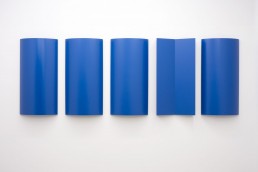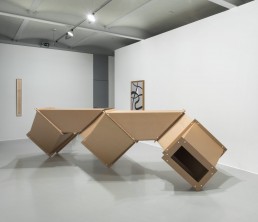
“You can proceed according to a set program or you pick individual possibilities according to your personal taste. After all, there’s enough of them. Don’t worry if you’re never ‘done,’ because the re-combination could proceed in perpetuity without ever becoming boring.” - Charlotte Posenenske
Artland’s Lost (and Found) Artist Series focuses on artists who were originally omitted from the mainstream art canon or largely invisible for most of their career. German Minimalist artist Charlotte Posenenske exhibited widely alongside her peers during the years in which she was active as an artist. Yet in 1968, at the age of 37, she stopped producing new work and made an unexpected U-turn in her career. Posenenske’s early retirement from the art world and her untimely death from cancer at the age of 54 practically erased her name from the history of art and the art world. A current retrospective of her art at Dia:Beacon entitled “Charlotte Posenenske: Work in Progress” shines light on the artist and covers her artistic practice produced over a period of 12 years, ranging from drawings and paintings to sculptures. The exhibition runs through 9 September 2019.
About Charlotte Posenenske
Charlotte Posenenske (1930–1985) was a German artist and sociologist. She was born in Wiesbaden, and suffered great traumas in her young years as her Jewish father committed suicide during the Second World War and she was sent into hiding. After the war, during the early 1950s, she formally trained as a painter under Willi Baumeister in Stuttgart. She briefly worked as a costume and set designer in Lübeck and Darmstadt, before fully focusing on the visual arts.
Posenenske was active as an artist in Germany between 1956 and 1968. During this period, she created works that were in dialogue with international movements of the time, including Art Informel, Group Zero, Minimalism and Conceptualism. Early on, Posenenske developed experimental techniques for applying colour and line to paper and board. These were first explored in abstract drawings and paintings, then in spray-painted wall structures at the intersection of painting and sculpture, and in murals on the facades of buildings.
Charlotte Posenenske’s Minimalist Sculptures
During the years that she was active as an artist, Posenenske exhibited widely alongside peers including the Minimalist artists Hanne Darboven, Donald Judd, and Sol LeWitt. Yet her work was very specifically distinguishable by how radically open-ended it was. Posenenske embraced reductive geometry, repetition, and industrial fabrication, and in doing so developed a form of mass-produced Minimalism that addressed the pressing socioeconomic concerns of her time. She chose to circumvent the art market and rejected the established formal and cultural hierarchies. Posenenske invited the collaborative engagement of the public in the continual reconfiguration of her sculptures.



Participatory Sculptures
With her series of sculptures which she named Vierkantrohre (Square Tubes), she created a set of participatory works. The sculptures resemble steel air ducts and can be reconfigured by the people who buy her work – Posenenske preferred to call them “consumers.” These consumers can purchase and install the different elements in any combination they wish. The pieces are separately sold square, rectangular, connecting, and bracing “T” forms made from galvanized sheet steel. What’s more, Posenenske chose for the works to be sold at the cost price of their materials. For her, the work was in no way about making a profit.
In the last two years of her practice, Posenenske developed five industrially fabricated, mass-produced series of modular, geometric sculptures (Series B, C, D, DW, and E). Within each series, the elements are activated by their consumers – they are invited to assemble the parts into completely unique combinations. Posenenske considered these sculptures to be collaboratively authored by herself, the artist, the workers who fabricated the pieces, and the consumers who combined the pieces. Posenenske worked in unlimited editions, considering her designs as prototypes for mass production. By doing this, she addressed socioeconomic concerns by avoiding the concept of “rarefied objects.”

“Though art’s formal development has progressed at an increasing tempo, its social function has regressed. It is difficult to come to terms with the fact that art can contribute nothing to the solution of pressing social problems.” - Charlotte Posenenske
Leaving Behind Art in Exchange for Social Engagement
Posenenske participated in important international solo and group shows in galleries and museums until 1967. But in 1968, she made a radical shift. She started by engaging more and more with public spaces to display her sculptures. Then, during the tumultuous May of 1968, she published the following statement in Art International:
“It is difficult to come to terms with the fact that art can contribute nothing to the solution of pressing social problems.” After releasing the statement, she ceased making and exhibiting art and instead went to do a PhD in sociology, focusing on industrial labour and advising unions.
Though Posenenske in a sense never turned back, she left behind a radical body of work that continues to challenge and inspire. A year before her death in 1985, fully aware that she should take care of her artistic legacy, she decided to put her art into production again. She authorised her estate to sell modern reconstructions of her sculptures.

Charlotte Posenenske’s Legacy
Posenenske’s original pieces from the 1960s are now considered “Prototypes,” and can only be purchased by public institutions. The works which are in continuous production are neither numbered nor editioned. Significantly, they are still being sold at the cost of production, plus overhead, just as Posenenske had stipulated. This means the resale value for her work is limited, and she therefore managed to avoid becoming a part of the troubling commercial art market.
Today, Posenenske’s work is found in major institutions including the Centre Pompidou and the Tate. Since her death in 1985, her work has finally gained renewed attention. It has been shown at Museum MMK für Moderne Kunst, Frankfurt (1990), Documenta, Kassel (2007), Museum of Modern Art, New York (2009), Artists Space, New York (2010), and São Paulo Biennial (2012). Now, the retrospective at Dia:Beacon, which can be seen until 9 September 2019, is helping place Charlotte Posenenske where she belongs as an artist, among some of the most important Minimalist artists of the 20th century.
